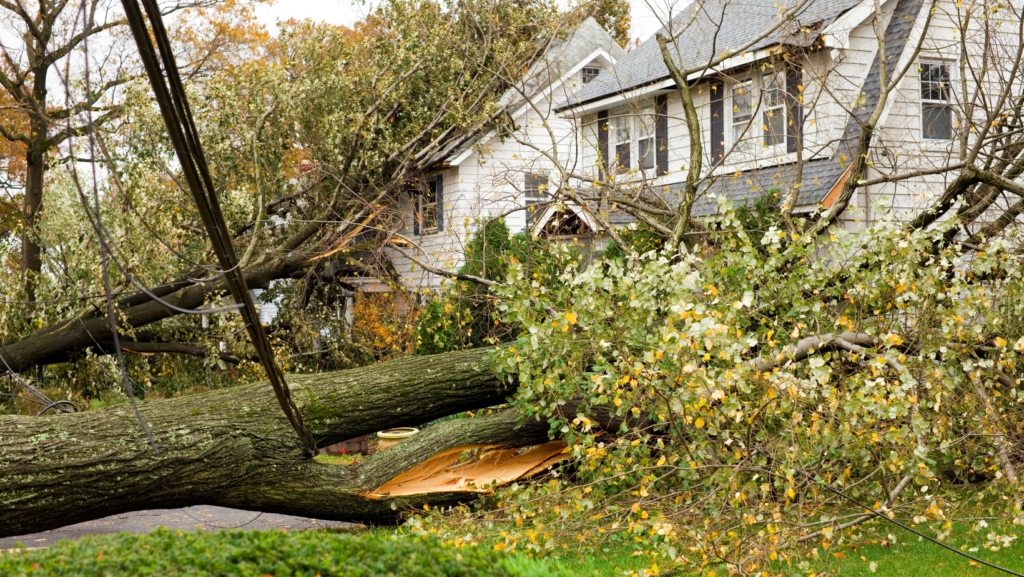Think your home is invincible? Think again. Storms are nature’s way of reminding us who’s really in charge, and they can leave your sanctuary in shambles. But don’t fret; we’re here to arm you with the knowledge you need to prepare, protect, and prevail.
According to the National Weather Service, storms caused over $1 billion in damages last year alone. So, are you ready to weather the storm?
Wind Damage: The Invisible Hand That Packs a Punch
You can’t see it, but you sure can feel it. Wind damage is like a boxer in the ring—swift, powerful, and potentially devastating. It can rip off shingles, break windows, and even uproot trees that could crash into your home.
How to Prepare: Reinforce your windows and doors. Consider installing storm shutters.
Pro Tip: Trim trees and remove dead branches well before storm season kicks in.
Water Damage: The Silent Invader
Water has a way of finding the path of least resistance. And trust us, it will find a way into your home if given the chance. Whether it’s through a leaky roof or a flooded basement, water damage can lead to mold, electrical issues, and structural decay.
How to Prepare: Regularly inspect your roof and gutters. Make sure your sump pump is in working condition.
Critical Analysis: Most homeowner’s insurance doesn’t cover flooding. You might want to look into additional coverage.
Electrical Damage: A Shock to Your System
Lightning doesn’t just strike trees. It can hit your home, causing fires and frying your electrical system. Even a nearby strike can send a power surge through your home, damaging appliances and electronics.
How to Prepare: Install surge protectors
Pro Tip: Unplug appliances during a storm to prevent potential electrical damage.
Structural Damage: The Hidden Enemy Within
Your home is your fortress, but even fortresses can crumble. Structural damage is the silent enemy that weakens your home from the inside out. It can result from any of the previously mentioned types of damage, making it a double whammy.
How to Prepare: Regular inspections are key. Look for cracks in the foundation and walls.
Critical Analysis: Post-storm, consider hiring a structural engineer to assess the integrity of your home.
Debris Damage: It’s Not Just Skyfall
When the wind howls, it’s not just rain and hail you need to worry about. Debris like branches, rocks, and even patio furniture can become airborne missiles. Yep, that garden gnome could be a projectile.
How to Prepare: Secure or store outdoor items that could be picked up by the wind.
Statistic: The National Oceanic and Atmospheric Administration reports that wind-borne debris causes up to 30% of hurricane-related injuries.
Secondary Damage: The Aftermath You Didn’t Anticipate
You’ve weathered the storm, but are you prepared for the aftermath? Secondary damage includes things like mold growth and electrical fires. It’s the stuff you don’t think about until it’s too late.
How to Prepare: Act fast on repairs to prevent further issues.
Pro Tip: Keep an emergency kit with essentials like water, food, and first aid supplies.
Storm-Proof Your Home with Disaster Management Recovery Group
You’ve just navigated the stormy waters of home damage, and guess what? You’re now better equipped than ever to protect your sanctuary.
Key Takeaways:
- Wind and water are more treacherous than they seem.
- Your home’s structure is its backbone—keep it strong.
- Debris and secondary damage are the silent threats.
- Preparation is your best defense.
Now, if you’re looking for the ultimate ally in this battle against the elements, check out DMRG. They’re the pros in disaster management and recovery. With their expertise, you won’t just weather the storm—you’ll own it.


